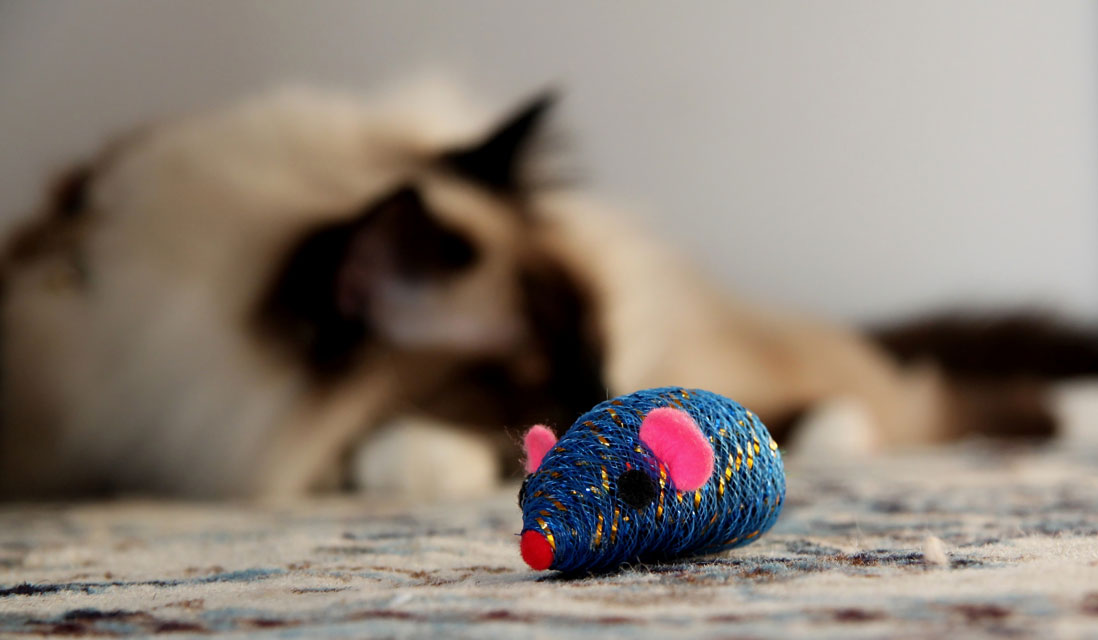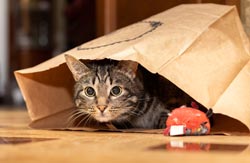How to Keep Playtime Fun for Your Cat

You may know this scenario: Playing with your cat used to be a piece of cake. You’d pick up a toy, any toy, and toss it along the floor. Your kitty would chase after the toy, swat it, pounce on it, and generally amuse himself. He and you would get a lot out of one throw. But these days, you get much more exercise than your cat when you try to initiate playtime. You repeatedly throw the catnip mouse and fetch it, while your kitty watches. What happened to the fun times?
Why Is Your Cat Playing Less?
There are a number of possible factors that could diminish your cat’s interest in playing:
- If the interest has declined rapidly, there could be an underlying medical problem. So the first step in this case would be to consult your veterinarian.
- It is also possible that a cat will be reluctant to play if he is depressed or chronically stressed. Usually, there are other things going on that are causing this, so those need to be addressed. But note that playing is very often part of the therapy for restoring normalcy; play can be a wonderfully effective way of boosting a cat’s mood and confidence.
- If your kitty’s enthusiasm for play has gone down gradually over the years, that could be a normal function of getting older. Or it could indicate boredom with the same old routine. Fear not—there are many ways you can rekindle your cat’s interest in playing, even if you have to take the activity level down a notch for your older or “couch potato” cat.
Is the Overall Home Environment Conducive to Cat Fun and Exploration?
You may be thinking, “I need to get some new toys . . . or think up some new techniques to get my kitty to play more,” and while you may be right, and we’ll get to those topics, let’s look first at some steps you can take to engage your cat’s mind and creative sense between play sessions.
Does your home have interesting sights and smells from a kitty’s point of view? Just as we add artwork, backyard gardens, and potpourri to enhance our experience at home, we can do the same for our cats.
Bird Feeders and Baths
A bird feeder and birdbath, dutifully filled and maintained and in plain view from a window, can be an endless source of pleasure for your cat, not to mention the birds. To avoid frequent frustration for both cat and birds, make sure the feeding and water stations are not too close to the window. In other respects, determine proper placement of the feeder and bath to maximize their value to the birds, so that the birds and kitty get the most out of the arrangement.
Bags and Boxes
Paper bags and cardboard boxes are two items of modern life that are in abundance, usually free, and easy to come by. They are also versatile, classic “objects of interest” to felines.

Most cats cannot resist at least checking out a paper bag lying on its side; chances are your cat will, at minimum, poke his head inside and take a cursory look. He is also likely to step completely inside, turn around, and wait for you to remark that “kitty is nowhere in sight” before deciding that it’s time to let the stealthy cat out of the bag and surprise you. For added stability, tear the top corners of the bag and make a one-inch cuff before laying it on its side. You can also upgrade the comfort level of the bag by lining the bottom, once it’s on its side, with a towel.
Hardware stores often sell large paper bags for outdoor waste. These heavyweight bags are about four feet in height—or rather, length, once tipped on their sides. They’re long enough so that you can use a scissors to add a window or side entrance. Your kitty may be fascinated by these bags, which are more like mini-caves, at least for a while. Don’t be surprised if he occasionally decides to take a snooze in them.
For safety, snip or remove any handles on bags to which your kitty has access and never use plastic bags.
There are many ways you can use cardboard boxes to entertain cats. They’re possibly the best bargain in the world for anyone living with a cat: free, easy to procure, recyclable, rugged, and multi-purpose. Nearly any office or store has extra cardboard boxes, and of course everything is shipped in cardboard. Here is a partial list of how you can use a cardboard box to enrich your cat’s life and spark his curiosity:

- Open the top flaps of the box so your kitty can sit in it—in classic cat fashion.
- Some cats like to be shuttled around in their box-mobiles, by willing humans who push them around. Be sure to make some stops along the way if your kitty wants to sniff the immediate surroundings.
- Turn the box into a human-propelled glass-bottom boat by cutting a small hole in the bottom of the box. As the kitty, with your help, traverses the various rooms in the house, the ever-changing display through the bottom “window” will capture his attention, and he may be inspired to paw and scratch at small items that suddenly appear as you run over them.
- Large boxes, singly or joined together, can serve as makeshift tunnels, not to mention another place to sleep.
- Cut a small hole in the box. Insert a treat or toy that your cat can extract.
Tips to Upgrade the Interactive Play Experience for Your Cat
There’s no substitute for interactive play. It’s not much fun for a cat to “chase” a stationary object. You bring the toy to life, and this makes all the difference.
When a catnip mouse is lying on the floor, your kitty has to swat it to make it scurry across the room. Not only is this extra work but it largely removes the element of surprise and challenge for your cat. It’s much more exciting when the toy, through your throws, tosses, and other guiding actions, seems to move on its own, in a prey-like manner.
Here are some hints on how to bring out your cat’s “inner kitten” during interactive play sessions:
- Manipulate toys such as catnip mice so that they act like nimble, ground-dwelling prey. They should dart out of sight and into hiding places, peek out, climb walls, and occasionally panic and make mistakes—to kitty’s advantage. When stationary, they may make tiny movements such as flicking their tails or twitching their noses-these may be entrancing to your kitty. They should tire and weaken after repeatedly being hit and clawed. Remember that prey tends to run away from a predator; a toy heading toward a kitty may trigger a response to flee rather than to pursue.
- Use wand toys to simulate birds or butterflies. The object at the end of the wand can flutter by, take off, and alight on surfaces as in real life.
- Use cardboard boxes as props in “play-hunt” scenarios. Have the prey jump into one end of the box and out the other, perhaps pausing for a moment in between. The prey can peer beguilingly from the top ledge or rappel down the side. Perhaps a quivering tail will disappear around the corner. Your imagination is your only limit. Be prepared for your kitty to thoroughly destroy the boxes as the fun mayhem ensues. That’s okay, you can always get some more.
- Refresh old toys with a blast of catnip spray or honeysuckle spray for cats that don't respond to catnip. You may be surprised at your cat's resurgence of interest in playing with these "refurbished" toys.
- Check out new products. There are always innovative variations of wand and throw toys coming out, as well as toys such as the Undercover Mouse, which may encourage solitary play but also works well with human involvement.
- Give your kitty the right amount of challenge. If it’s too easy or too difficult to catch the toy, the cat will get bored. Find the sweet spot. The “prey” should be smart and quick, so the cat has to exercise his mind and body. But let him have plenty of satisfying pounces, whacks, and bites that he inflicts on his prey.
- Don’t force the game to continue when it’s clear that your cat has lost interest. End when your kitty decides it’s over. This helps keep playtime fun and something to which your cat looks forward.
- At the conclusion of the play session, give your cat a favorite treat to consummate the hunt and reward his superior and impressive efforts.
- Put interactive toys away when not in use. If the toy is lying on the floor all day, it's essentially dead prey to your kitty, which is not too exciting. When you store a toy in a location that’s hidden or at least inaccessible to the kitty and bring it out for a play session, it comes alive and you introduce surprise and novelty. The occasional exceptions to this rule are toys that are practically like a “blankey” to your cat; he never tires of them.
Investing in Play for Your Cat Yields Multiple Benefits
Author and cat behavior expert Pam Bennett-Johnson calls cats’ playing “serious fun.” And Shakespeare said “The play’s the thing,” They’re both right. Daily play can help your cat become more fit, maintain a healthy weight, stay mentally sharp, increase confidence, and avoid boredom and depression. An ounce of prevention through regular play sessions is worth a pound of cure, and it may take off a pound of fat. By putting the spark back in your cat’s playtime activities, he will enjoy numerous benefits and you’ll have a healthier and happier feline friend.
You May Also Like These Articles:
How to Play With Your Cat- Part One
How to Play With Your Cat- Part Two
Cat Weight Loss: How You Can Help Your Cat Lose Weight
Notice: Ask-a-Vet is an affiliated service for those who wish to speak with a veterinary professional about their pet's specific condition. Initially, a bot will ask questions to determine the general nature of your concern. Then, you will be transferred to a human. There is a charge for the service if you choose to connect to a veterinarian. Ask-a-Vet is not manned by the staff or owners of CatHealth.com, and the advice given should not delay or replace a visit to your veterinarian.





